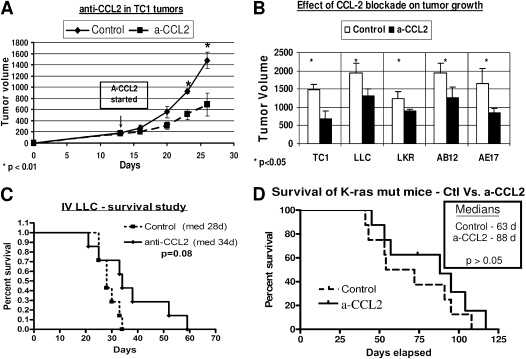Figure 1.
Monocyte chemoattractant protein–1 (CCL2) blockade inhibits the growth of thoracic malignancies. (A and B) Mice (n = 5–8 for each group) bearing 200-mm3 flank tumors were treated with either saline (Control) or intraperitoneal α-CCL2/CCL12 monoclonal antibodies (mAbs) twice per week (a-CCL2). (A) Growth curves of tumors with these treatments in the non–small-cell lung cancer (NSCLC) cell line tissue culture 1 (TC1) (*P < 0.01). (B) Differences in tumor volume between control and α-CCL2–treated mice, at the time that the size of tumors in control mice was above 10% of their weight, in three NSCLC cell lines (TC1 and Lewis lung carcinoma [LLC] at 25 days, and lung cancer K-ras (LKR) at 40 days), and two mesothelioma cell lines (AB12 and AE17 at 35 days) (*P < 0.05 versus control for each). (C and D) Effects of α-CCL2 blockade were evaluated in two orthotopic NSCLC tumors: intravenous (IV) LLC (C) or a k-ras mutation model (D). Mice (n = 7–9 for each group) were treated with either saline (control) or intraperitoneal α-CCL2 mAb twice per week (a-CCL2). A trend toward increased survival was evident with CCL2 blockade.

